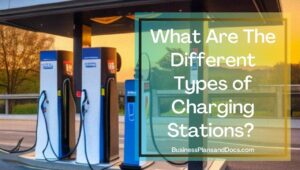With well over two million cars on the road and accounting for over 2.6 percent of all global vehicle sales, electric vehicles are more popular than ever and are gaining even more traction each year. While most electric vehicles have mileage ranges that are sufficient for daily usage, they still have to be charged during longer trips. Charging stations are popping up across the country, and provide a solution to this problem. However, many more charging stations need to be opened before electric vehicles can be considered serious competition for gas-powered cars and trucks. How can you get the necessary funding to open more charging stations?
The three ways in which you can secure funding for an electric vehicle charging station include the following:
- Grant programs offered by the United States Department of Transportation/Federal Highway Administration
- Loan programs available through the United States Department of Energy
- Tax credits and incentives are available to those who purchase electric vehicles
In this article, we are going to examine the different types of charging stations available for powering your electric vehicle. I will also provide you with a guideline on how to get started if you choose to open your own commercial electric vehicle charging station. This is where you will find information regarding the many types of Grant and loan programs available for electric vehicle charging stations. Finally, we will also go into detail regarding the federal tax incentive programs available to Consumers who wish to purchase an electric vehicle.
What Are The Different Types of Charging Stations?

As the nation’s mindset becomes more environmentally censored, we will see an increase in the demand for electric vehicle charging stations, of which there are three types. Aside from the difference in charging speeds, another significant difference between the three types of electric vehicle charging stations is the cost to implement them. According to the Treehugger website, the three types include Level One, Level Two, and Level Three charging stations.
Level One charging stations amount to nothing more than the medications you make to your home to charge your electric vehicle. The two types of commercial charging stations found around the United States include Level One and Level Two charging stations. Level Two charging stations are amongst the most popular stations currently found throughout the United States and are slower than Level Three stations.
Level Two charging stations are portable power packs that can be connected to specially adapted DC charging stations, and provide approximately 20 miles of charge per hour that they are connected. Per JD Power, these charging stations can charge an electric vehicle in approximately one-quarter of the time it would take a Level One charger to complete the same task.
The third type of electric vehicle charging station commonly found around the globe is the Level Three charging station. Providing between 400 volts and 800-volt charging, these charging stations can fully charge an electric vehicle in approximately an hour. If you have ever found yourself having to stop at a commercial electric vehicle charging station in the middle of a cross-country trip, you have used a Level Three charging station.
What Grant Programs Are Available to Start EV Charging Stations?
The ever-increasing use of electric vehicles as a viable alternative to those traditionally powered by fossil fuels represents a drastic shift in the mindset of our planet. Commercial electric vehicle charging stations are now being implemented both across the United States and around the globe. Whereas vehicles that are powered by gas and diesel fuels are still amongst the most popular vehicles on the road, it is also not uncommon to see electric charging stations popping up to accommodate the rising popularity of electric vehicles.
The first step in making electric vehicles a viable replacement for gas and diesel-powered engines is to make topping off your electric car’s battery just as easy as it is to refill your gas tank. The US Department of Transportation has established several grant programs that are available to improve the infrastructure of our nation to accommodate the increasing demand for more practical ways to charge electrical vehicles. The National Electric Vehicle Infrastructure Formula Program will provide five billion dollars to strategically deploy electric vehicle charging across the United States, as well as a way to improve the data collection, access, and reliability of these charging stations.
The Discretionary Grant Program for Charging and Fueling Infrastructure is another grant in place that provides over 2.5 billion dollars to expand publicly accessible vehicle charging stations and other alternative refueling options to areas that would not otherwise have access to this type of infrastructure. The language of this grant requires that at least 50% of the funds be used in areas that would normally be considered rural areas, low-to-moderate income neighborhoods, and communities that have a low ratio of private parking spaces.
How Do You Make Money Renting Office Spaces?
Are There Loans In Place For EV Charging Stations?
The United States is currently witnessing an explosion in the popularity of electric vehicles. As the use of electric vehicles continues to become more and more popular, the demand for electric vehicle charging stations across the United States will also increase. This presents economic opportunities to those who have an eye toward the future. However, securing an adequate amount of start-up capital is necessary to take advantage of these opportunities.
According to The Vermont Economic Development Authority, there are loans in place to help you secure funding if you want to open an electric vehicle charging station. These loans stipulate that you must use the funds to either purchase or install an electric vehicle charging station that is made readily available to the general public. These loans have available for up to $100,000; have a 1% fixed interest rate, and the terms are dependent on the useful life of the asset.
What Are The Tax Credits and Incentives Offered By Purchasing An Electric Vehicle?

In this article, we have covered a few of the grants that are available to improve the infrastructure of areas that wish to incorporate the use of electric vehicle charging stations as a part of everyday life. We have also discussed the fact that there are loans available for those who wish to either open or purchase electric vehicle charging stations. Surely, there must be tax credits and incentives available for those who are in the market for an electric vehicle.
Fortunately, the federal government provides tax credits and incentives covering 30% of the hardware and installation costs of electric vehicle chargers up to $1,000. These credits and incentives are also reactive, which means that they can cover hardware and installation cost dating back to as early as 2017, per EV Charging. There are also more than 30 cities in the United States that offer utility rebates that range from $150 to $750 for the purchase of residential electric vehicle charging equipment.
Several utility companies are also beginning to understand the importance of making the echo-friendly shift towards using electric vehicles in an attempt to reduce carbon emissions. However, there is a catch. Because Network electric vehicle charging stations drastically reduce the demand on the grid infrastructure, these rebates are offered specifically for smart, Network electric vehicle charging stations such as JuiceBox Pro and Enel X’s. Rebates range from $1,000 for portable, Level Two charging stations to $30,000 for Level Three fast-charging commercial stations.
Conclusion
In conclusion, there has been a conscious effort to reduce the number of carbon emissions polluting our environment by encouraging the switch to electric vehicles. Federal grants have been made available through the US Department of Transportation for the development, research, and implementation of fast-charging EV stations across the United States. These grants are in place to encourage the development of an infrastructure that can sustain the practical use of electric vehicles in our everyday lives.
Loans of up to $100,000 can be secured as a way to develop infrastructures in rural or low-income areas where the switch to electric vehicles may not seem as practical as it would be in larger cities. Last, but certainly not least, there are several tax rebates and incentives available for all types of EV charging stations. These rebates apply to both Level Two portable stations and Level Three commercial, fast-charging stations. There are also utility rebates available to help cover the cost of the installation and equipment needed for a Level One home charger.
Five Tips To Successfully Pitch A Mobile App Idea To Investors
Frequently Asked Questions
Which states are best for owning an electric vehicle?

While there has been a concerted effort to shift towards the use of electric vehicles, there are three states that stand out amongst the rest when it comes to electric vehicles. These states include California, Florida, and Texas. Factors that determined these results included a number of registered electric vehicles in each state; the number of electric vehicle charging stations found in each state, and the population of each state.
Which charging network is the largest electric vehicle charging Network in the United States?
Just like you have several options when it comes to the type of gas you use in your car, you also have a choice in choosing which charging network you use to recharge your electric vehicle. As of December 31st 2021, the largest electric vehicle charging network in America is Tesla, with an astounding 58% of all EV charging stations. The second largest charging network is Electrify America, powering 14.4% of the charging stations in the United States.
To learn more on how to plan your own EV charging station business click here!
Please note that the contents of this blog are for informational and entertainment purposes only and should not be construed as legal advice. Any action taken based on the information provided in this blog is solely at your own risk. Additionally, all images used in this blog are generated under the CC0 license of Creative Commons, which means they are free to use for any purpose without attribution.

About the author. A lifetime of Entrepreneurship.
Hi! My name is Shawn and I am a happy individual who happens to be an entrepreneur. I have owned several types of businesses in my life from a coffee shop (link here http://archives.starbulletin.com/2003/05/18/business/index.html) to an import and export business to an online review business plus a few more and now I create online resources for those interested in starting new ventures. It’s demanding work but I love it. I do it for those passionate about their business and their goals. That’s why when I meet new business owner, I see myself. I know how hard the struggle is to obtain and retain clients, finding good employees and making sure everything works together all while trying to stay competitive.

